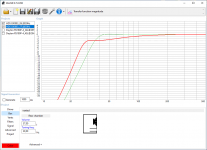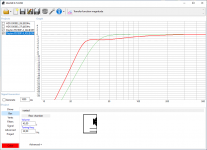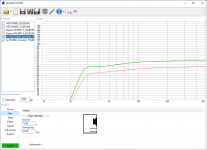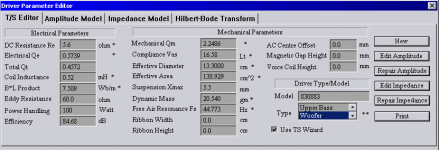Excuse me, I didn't see it.. What's the real advantages of a dual series driver since, with the same input in volt, it will reach the same SP of a single driver system but in a doubled cabinet, other than doubling impedance, I can imagine the halving excursions and consequently increasing max SPL, right?Andrea, the two woofers are wired in series as I stated on my attachment in the heading.
The primary advantage is the increased SPL, and wiring the two drivers in series is a necessity. A pair of RS180-8 wired in parallel will end up with about the same SPL, have a lower fs and may play lower, but their aluminum cones will have more ringing to deal with than the RS180P with their paper cones. Just some of the many compromises involved with speaker design.Excuse me, I didn't see it.. What's the real advantages of a dual series driver since, with the same input in volt, it will reach the same SP of a single driver system but in a doubled cabinet, other than doubling impedance, I can imagine the halving excursions and consequently increasing max SPL, right?
Thank you for your suggestions, I've found that formula in a post of a famous loudspeaker designer on another platform's forum as a method for a first and quick orientation about a woofer loading requirements, however my congratulations for your long experience.
You're welcome!
Please let me know if you remember.......
Thanks?
is 'expanding' a tapering in which terminus is placed on the largest part of pipe?
is the tapering ratio depending by the difference between QTS and 0.403 value?
Correct, though ideally it's Qts'; to some extent, though again, MJK's doc gets one a basic tapered max flat alignment, but requires using compression horn design for higher efficiency alignments or nowadays just 'sliding' one's way to a 'close enough' one in HR's Loudspeaker Wizard.
how did you calculate 939 Hz of cross point
'Sound is round', so to speak, i.e. an exponential expansion [1/f] = octave spread, so to find a driver's acoustical half power/XO point [-f3D] we need to know where it's no longer pistonic = the effective diameter of the VC, so a 'close enough' frequency [VCf] for speaker design is its published dia., then -f3D = sqrt [VCf * Fs] and if more XO points, then 2-f3D = sqrt[VCf *-f3D], 3-f3D = sqrt[VCf * 2-f3D], etc..
Thanks (as always) Greg! I thought it had to be something on those lines, but the brain is not firing on all 4 at the moment (let alone 8 😉 ).
Last edited:
..obviously I don't remember..! : )You're welcome!
Please let me know if you remember.......
...CUT...
'Sound is round', so to speak, i.e. an exponential expansion [1/f] = octave spread, so to find a driver's acoustical half power/XO point [-f3D] we need to know where it's no longer pistonic = the effective diameter of the VC, so a 'close enough' frequency [VCf] for speaker design is its published dia., then -f3D = sqrt [VCf * Fs] and if more XO points, then 2-f3D = sqrt[VCf *-f3D], 3-f3D = sqrt[VCf * 2-f3D], etc..
Thank you for all these info.
Paul, yours seems really to be the perfect MTM, but let me explain my concern and my supposed preference for a dual HDS 830883 in parallel, here's some quick sim with WinISD. Please note that 830883's parameters are measured by Zaph while RS180P-4's parameters are declared by manufacturer.The primary advantage is the increased SPL, and wiring the two drivers in series is a necessity. A pair of RS180-8 wired in parallel will end up with about the same SPL, have a lower fs and may play lower, but their aluminum cones will have more ringing to deal with than the RS180P with their paper cones. Just some of the many compromises involved with speaker design.
This is a single 830883 in its optimal QB3 loading (green line, 26 liters @39 hz) and in its extended alignment (red line, 37 liters @ 30Hz), for which I've had to enlarge cabinet of about 40%:

This is instead a single RS180P-4 in its optimal QB3 loading (green line, 24 liters @38 hz) and in its extended alignment (red line, 45 liters @ 29Hz), for which I've had to enlarge cabinet of quite 100%:

Can I be sure that enlarging too much loading volume for a driver with a quite low QTS as that may not be dangerous from a sonic quality point of view?
Last, here's an overlapping between our two MTM, a dual 830883 in parallel (green line) and a dual RS180P-4 in series (red line), both in a 75 liters cabinet tuned @ 30 Hz, in which my results are quite different from yours in terms of extension, where systems are driven with the same voltage:

It's obvious that 830883 is more sensitive but it's not that important for me.
Wouldn't you make one last sim for this dual 830883 in parallel to make an expert comparison between these two systems? I'd thank you more and more.
If you want, here's 830883 Zaph's specs:

Thank you again!
Note that what Paul has given you is not a T/S derived vented box using pure cavity resonance. It's a quarter-wave variation, so your simple lumped element modelling based purely on cavity resonance is inaccurate as it is only showing Fb, not the actual alignment (these are not synonyms). Out of interest I took a quick look at Paul's box and as expected got identical results. There is certainly nothing 'dangerous' about it within the context of what it is -a compact MTM with a pair of 6 1/2in midbass drivers. Excursion is not unreasonable, settling time & GD are OK, air velocity through the duct is modest, nothing noteworthy in the acoustic impedance either.
Last edited:
Adding to what Scottmoose said, I suggested the pair of RS180P-4 drivers because I have used them for a personal build and they are a very good value price-wise and performance-wise. I also have no issue against the Peerless drivers you've modeled, Andrea.
Paul
Paul
I just modeled the same 75-liter ML-TL cabinet I modeled for the pair of RS180P-4 drivers but for the Peerless drivers in WTW format with the drivers wired in parallel and with 0.3 ohms added in series with them. I made the port a bit larger and longer in order to keep the peak port air velocity below 17 m/s, the tweeter's center is located 10" below the internal top, and the port's center located 3.5" above the internal bottom. The system tuning frequency is 31-32 Hz. The resulting nominal impedance is 3.2 ohms and it took an input of 45w/1m to cause the drivers to first reach Xmax. The resulting f3 was 30 Hz, compared to 31-32 Hz for the RS drivers, and what was a bit surprising, both designs were generating exactly the same SPL, 105.7 dB (but the RS180 design required a smaller input of 37w/1m). It doesn't really matter to me, but both designs are identical at Xmax while differing in f3 by 1 Hz or so.
Paul
Paul
Here's the comparative set of modeling graphs for the dual Peerless drivers in the same 75-liter cabinet modeled for the RS180p-4 drivers.
The primary advantage of the Peerless design is its higher sensitivity for an input of 2.83v/1m. Both driver designs output the same SPL when their drivers are driven to their Xmax excursions, however, and their resulting F3s are almost identical, close enough to not be audibly different.
The primary advantage of the Peerless design is its higher sensitivity for an input of 2.83v/1m. Both driver designs output the same SPL when their drivers are driven to their Xmax excursions, however, and their resulting F3s are almost identical, close enough to not be audibly different.
Attachments
- Home
- Loudspeakers
- Multi-Way
- Monacor SPH-220HQ 8'' woofer in a 2 way